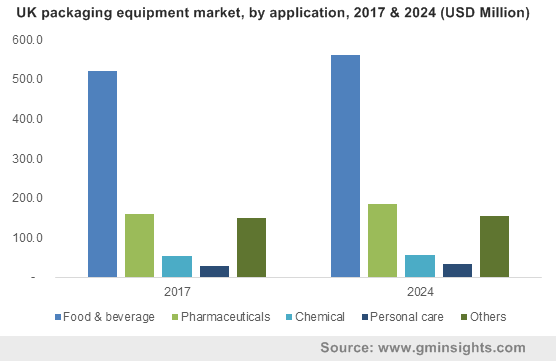Packaging machinery market to gain enormous proceeds from the food & beverage segment over 2018-2024, pharmaceutical applications to boost the demand for fillers
Publisher : Fractovia | Published Date : 2018-09-18Request Sample
The rapidly growing population and the gradual rise in consumer spending has propelled the packaging machinery market, which garnered remunerations of about USD 38 billion globally in 2017. Demand for packaged food and beverages has been continuously increasing and consequently has presented vast opportunities for packaging companies. As a result, the packaging machinery industry has seen tremendous demand from food processing and bottling plants, where large sized machines help in packing thousands of units of multiple product ranges each day. The availability of numerous beverage options on supermarket or grocery store shelves has boosted the popularity of major as well as emerging brands, encouraging them to expand production. With the demand for beverages such as juices, soft drinks and energy drinks expected to grow steadily, the packaging machinery market will be proliferated by the consistent need for fillers to produce bottled or canned beverages.
UK packaging equipment market, by application, 2017 & 2024 (USD Million)

Filling of bottles require efficiency, accuracy and reliability in operations, which is achieved by acquiring packaging machinery suitable to each kind of beverage segment. The packaging machinery market consists of several manufactures that provide machines depending on the type of liquid or powder to be filled and the scale of production. The sale of beverages is influenced by the changing lifestyle and health concerns, which has created a platform for the development of different categories of flavored drinks and juices. Coca-Cola is the world’s biggest beverage company which offers more than 500 sparkling and still products as well as almost 3,900 beverage options to consumers, from production facilities located world over. According to statistics disclosed by the company, over 1.9 billion servings of beverages offered by Coca-Cola are consumed everyday across nearly 200 countries, demonstrating the penchant for packaged drinks and the growth potential for fillers in packaging machinery market.
Trends observed in countries like the U.K., U.S., Canada and many other developed nations show that juices have become an integral part of a healthy breakfast and coerce people into buying packaged juice products on a regular basis. This has not only bolstered the packaging machinery industry revenues from established companies, but also from upcoming businesses focused on health drinks and fulfilling the daily nutritional requirement of consumers. Also, soft drinks are included as a part of most of the meals being consumed outdoors in restaurants or delis and are a key accompaniment for junk food. In 2014, the total spending on fruit & vegetable juices and other soft drinks in the U.K. was reported to be more than GBP 8.6 billion. Separately, the U.S. Department of Agriculture had issued a report in 2016, which stated that soft drinks amounted to more spending in the U.S. as compared to any other food item and represented about 9.3% of overall food expenditures.
Evidently, the increasing demand for packaged drinks is also attributed to the exponentially growing population base in regions like Asia, Africa and South America, ensuring the existence of willing consumers for a large number of beverage alternatives. As such, bottle filling machines will contribute enormously towards the packaging machinery market earnings, since there are no indications to suggest a plunge in beverage demand over the coming years. The pharmaceutical segment can also be expected to offer significant growth prospects for the packaging machinery industry, as the need for effective drugs and medicines is always on the rise. Packaging for pharmaceutical products require standardized materials and displaying a variety of information is mandated by government and international agencies. Different machines are required for distinct stages of packaging, such as filling, sealing, sticking informational labels and capping.
A huge proportion of medicinal products available in the market are in liquid form and are filled in vials or bottles, necessitating the use of fillers to warrant a cost-effective, safe and accurate packing of the liquids. Common illnesses such as cold, cough, gastrointestinal problems and others are usually treated using liquid medicine packed in multi-dose containers like vials and plastic bottles. The packaging machinery market, which apportioned 20% of its revenues in 2017 from fillers, delivers reliable filling machines to the pharmaceutical industry, designed for handling chemicals and allowing the use of industry specific packaging materials. The recently unveiled Dara HSL-PP/4 from ProMach is an example of advanced, high-speed aseptic filling equipment which has the capacity to fill nearly 200 vials per minute, from 0.1 to 200 milliliters of liquid. The machine enables accurate filling and quality control, besides ensuring safety of the materials being handled.
All in all, the packaging machinery industry will experience augmented demand from the rapidly expanding food & beverage segment as well as from the pharmaceutical applications that arise from rising prevalence of various diseases. Bosch Packaging Machinery, B&H Labelling, Aetna Group, Fuji Machinery Company, CKD Group, Krones Group and Harland Machine Systems are some prominent industry players in the packaging machinery market.